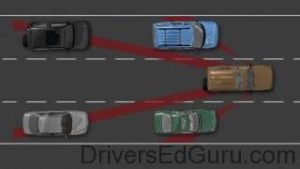How to Eliminate Blindspots with the BGE Mirror Setting

Probably every time you drive, you need to change lanes or merge into traffic. These routine maneuvers can cause dangerous situations because every vehicle has blindspots (also spelled blind spots or called blind zones). The National Highway Traffic Safety Administration estimates that there are 630,000 lane change/merge crashes each year, causing 225 fatalities. Needless to say, the “simple” act of changing lanes or merging requires precaution and practice.
Before understanding how to eliminate blindspots, your teen driver must first understand what a blindspot is. Blindspots are areas in which a vehicle cannot be seen in either the inside mirror, side mirrors, or the driver’s peripheral vision. Most drivers set their side mirrors so that they can just barely see the side of their car in the mirrors. By setting the side mirrors in this way and also using the rearview mirror, blind spots are reduced, but the size of these blindspots is still capable of hiding a vehicle.
The Blindspot and Glare Elimination (BGE) mirror setting was developed in 1996 by a member of the Society of Automotive Engineers named George Platzer. The BGE setting reduces the usual two large blindspots to four mini blindzones. None of these four mini blindzones are large enough to completely hide a car.
There are several advantages to the BGE setting:
- You no longer have to turn your head to look into the blindzones.
- Only a brief glance at the side mirror and inside mirror is needed.
- By glancing at the mirror, you keep the road ahead in your peripheral vision. Turning your head completely eliminates the road ahead from your field of vision.
- Glare from the side mirrors is almost entirely eliminated. You should no longer have a trailing car’s headlights shine directly into your eyes.
This is how to set up the BGE setting:
- Place your head against the driver’s side window and adjust the driver’s side mirror so you can barely see the driver’s side of your car.
- Move your head as close to the center of the car as possible and adjust the passenger’s side mirror so you can barely see the passenger’s side of your car.
- To check your BGE settings, watch as a car passes you in an adjacent lane. It should enter your outside mirror before it leaves the rearview (inside) mirror. Also, the car should appear in your peripheral vision before it leaves the outside mirror.
- Remember, your inside rearview mirror is your primary mirror and it will take time to get accustomed to no longer seeing the sides of your car in the side mirrors.
The following video also explains how to set your mirrors to the BGE setting:
The BGE setting should only be used in vehicles with an inside rearview mirror and two side mirrors. Do not use the BGE setting if you are carrying something that blocks the inside rearview mirror. Also, beware that many drivers are not familiar with the BGE setting, so when driving near other vehicles, you should stay out of the original blindspots whenever possible. Their mirror settings could have large blind pots around the vehicle.
Have your teen set his mirrors to the BGE settings and practice switching lanes and merging. Luckily, while your teen is getting comfortable and confident with the BGE settings, you’ll be in the car to double check his maneuvers.

